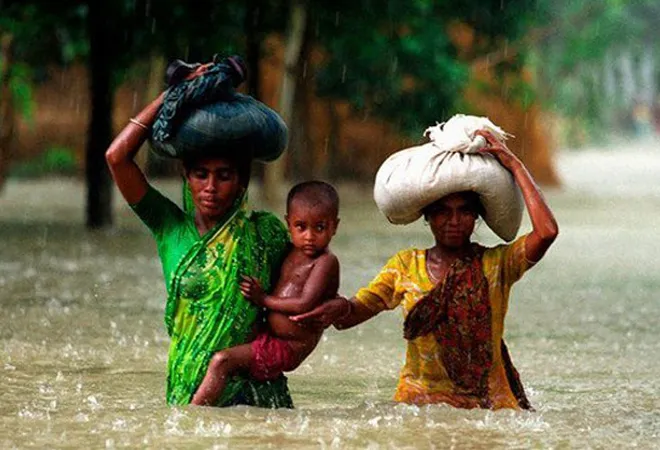
The climate crisis—a planetary phenomenon that impacts all people—has become one of the most pressing global challenges of the 21
st century. The warming of the planet, rising sea levels, droughts, and extreme temperatures have in fact, today, increased the frequency and severity of natural disasters, heightening the sufferings of millions of people.
Marginalised groups such as racial and ethnic minorities, and those belonging to lower socioeconomic backgrounds, however, experience the effects of climate change more intensely. Therefore, they need to be placed at the forefront of climate-adaptation strategies in times of pressing climate variability and ongoing change.
But among these marginalised groupings, it is the women who experience the most detrimental as well as disproportionate effects of climate change. In comparison to men, it is predominantly women who are more likely to live in poverty, have limited access to civil rights and democratic freedom, and are confronted with systemic violence that often escalates during periods of instability.
Climate change is a “threat multiplier”, which intensifies socio-economic and political tensions and exacerbates existing gender inequalities, thereby, posing unique threats to women’s health, livelihoods, and safety. Therefore, there is an urgent need to recognise climate change as an intersectional feminist issue, calling for more women to be represented in the formulation of climate solutions.
Climate change is a “threat multiplier”, which intensifies socio-economic and political tensions and exacerbates existing gender inequalities, thereby, posing unique threats to women’s health, livelihoods, and safety.
In many regions across the globe, women, in fact, depend more on natural resources and yet have limited access to them. Women and girls, especially in rural communities, bear the overwhelming responsibility for securing food, water, fuel and other household energy resources. But as droughts worsen, floods become common, rainfall gets more and more erratic, women are bound to travel longer distances and spend additional time securing these livelihood resources. For instance, when natural disasters like heat, droughts, and extreme temperatures dry up sources of water, affecting the availability of natural water, women and girls are forced to travel for miles and miles in search of water for cooking, bathing, cleaning, etc. As a result of which, they are left with little time to pursue self-rejuvenation activities and other household chores.
The rapid changes in the climate are, thus, only making it harder for women to manage their domestic responsibilities—like cleaning, cooking, gathering resources—and caring for the elderly as well as their children.
And, lest we forget, that for women in low- and lower-middle-income countries, the agricultural sector is the most important source of
employment. Consequently, during extreme weather events such as droughts, storms, hurricanes, floods, etc; it is these very women—as agricultural labourers and primary workers or procurers—who have to work harder in comparison to their male counterparts to secure an income, livelihood, and other necessary resources for their children as well as their families. This, however, puts additional pressure on young girls, who, in light of the ongoing calamities and scarcity of finances, are often forced to leave school and help their mothers manage the increased burden.
In addition, as the climate crisis continues to exert an economic burden on families, leading to the loss of their homes, livelihoods, and in some cases, even their lands, thereby, affecting the overall stability and security of the households, raising the risk of child marriage where marrying off their daughters at an early age becomes an easier option. Reports suggest that, in Malawi, for example, climate-induced devastation and vulnerability could, in fact, lead to an additional
1.5 million child brides in upcoming years.
According to the United Nations (UN), 80 percent of those already displaced by climate change and the consequent crisis globally are women.
Besides, over the past recent decade, displacement caused due to climate change—both within and across international borders—has also been on the rise across the globe and among the displaced individuals, the majority of those who have been forced out of their homes are women and young girls. This further puts them at great risk of trafficking, sexual exploitation and violence, including sexual violence. According to the United Nations (UN),
80 percent of those already displaced by climate change and the consequent crisis globally are women.
Women’s and girls’ health is also significantly endangered by climate change—predominantly owing to their pre-existing lack of access to health and medicare services—which further increases risks, especially those related to maternal and child health. Anecdotal evidence has, in fact, established a
direct relation between extreme heat and increased chances of stillbirth. Changes in the climate have also substantially increased the
spread of vector-borne diseases such as dengue, fever, Zika virus, and malaria—all of which are well-known to worsen maternal as well as neonatal outcomes.
However, despite their vulnerability and repeated marginalisation, women shouldn’t merely be viewed as victims of the climate crisis. They instead need to be appreciated as active and effective individuals that possess the innate ability to implement, design, as well as promote climate adaptation and mitigation approaches that could considerably help in coping with calamities.
Women have historically developed knowledge and skills related to natural resource management including food preservation and rationing, water harvesting and storage, etc. For instance, in Africa, women often embody
wisdom pools with traditional expertise and inherited local knowledge that revolves around understanding early warning signs and the effective mitigation of short as well as long-term impacts of disasters. Besides, women across the globe have also been leading climate action movements and providing a hand in developing alternative community models that focus on sustainability, conservation, as well as cooperation.
Changes in the climate have also substantially increased the spread of vector-borne diseases such as dengue, fever, Zika virus, and malaria—all of which are well-known to worsen maternal as well as neonatal outcomes.
Yet, women continue to be severely under-represented in climate forums and decision-making processes. But given their disproportionate impact, unique experiences and skills, there is an urgent need to give women full and equal partnership and leadership on climate issues. After all, women have proven multiple times that they can and, in fact, do play a critical role in responding to climate change owing to their local knowledge and leadership. Thus, beyond the boardrooms, women’s participation in spaces of power is the need of the hour to solve the current climate crisis.
Akanksha Khullar is a Visiting Fellow with the Strategic Studies Programme at ORF.
The views expressed above belong to the author(s). ORF research and analyses now available on Telegram! Click here to access our curated content — blogs, longforms and interviews.



 The climate crisis—a planetary phenomenon that impacts all people—has become one of the most pressing global challenges of the 21st century. The warming of the planet, rising sea levels, droughts, and extreme temperatures have in fact, today, increased the frequency and severity of natural disasters, heightening the sufferings of millions of people.
Marginalised groups such as racial and ethnic minorities, and those belonging to lower socioeconomic backgrounds, however, experience the effects of climate change more intensely. Therefore, they need to be placed at the forefront of climate-adaptation strategies in times of pressing climate variability and ongoing change.
But among these marginalised groupings, it is the women who experience the most detrimental as well as disproportionate effects of climate change. In comparison to men, it is predominantly women who are more likely to live in poverty, have limited access to civil rights and democratic freedom, and are confronted with systemic violence that often escalates during periods of instability.
Climate change is a “threat multiplier”, which intensifies socio-economic and political tensions and exacerbates existing gender inequalities, thereby, posing unique threats to women’s health, livelihoods, and safety. Therefore, there is an urgent need to recognise climate change as an intersectional feminist issue, calling for more women to be represented in the formulation of climate solutions.
The climate crisis—a planetary phenomenon that impacts all people—has become one of the most pressing global challenges of the 21st century. The warming of the planet, rising sea levels, droughts, and extreme temperatures have in fact, today, increased the frequency and severity of natural disasters, heightening the sufferings of millions of people.
Marginalised groups such as racial and ethnic minorities, and those belonging to lower socioeconomic backgrounds, however, experience the effects of climate change more intensely. Therefore, they need to be placed at the forefront of climate-adaptation strategies in times of pressing climate variability and ongoing change.
But among these marginalised groupings, it is the women who experience the most detrimental as well as disproportionate effects of climate change. In comparison to men, it is predominantly women who are more likely to live in poverty, have limited access to civil rights and democratic freedom, and are confronted with systemic violence that often escalates during periods of instability.
Climate change is a “threat multiplier”, which intensifies socio-economic and political tensions and exacerbates existing gender inequalities, thereby, posing unique threats to women’s health, livelihoods, and safety. Therefore, there is an urgent need to recognise climate change as an intersectional feminist issue, calling for more women to be represented in the formulation of climate solutions.
 PREV
PREV


